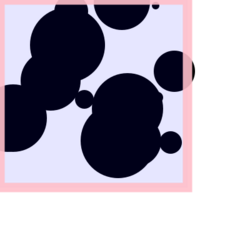Boolean model (probability theory)
 From HandWiki - Reading time: 2 min
From HandWiki - Reading time: 2 min
For statistics in probability theory, the Boolean-Poisson model or simply Boolean model for a random subset of the plane (or higher dimensions, analogously) is one of the simplest and most tractable models in stochastic geometry. Take a Poisson point process of rate [math]\displaystyle{ \lambda }[/math] in the plane and make each point be the center of a random set; the resulting union of overlapping sets is a realization of the Boolean model [math]\displaystyle{ {\mathcal B} }[/math]. More precisely, the parameters are [math]\displaystyle{ \lambda }[/math] and a probability distribution on compact sets; for each point [math]\displaystyle{ \xi }[/math] of the Poisson point process we pick a set [math]\displaystyle{ C_\xi }[/math] from the distribution, and then define [math]\displaystyle{ {\mathcal B} }[/math] as the union [math]\displaystyle{ \cup_\xi (\xi + C_\xi) }[/math] of translated sets.
To illustrate tractability with one simple formula, the mean density of [math]\displaystyle{ {\mathcal B} }[/math] equals [math]\displaystyle{ 1 - \exp(- \lambda A) }[/math] where [math]\displaystyle{ \Gamma }[/math] denotes the area of [math]\displaystyle{ C_\xi }[/math] and [math]\displaystyle{ A=\operatorname{E} (\Gamma). }[/math] The classical theory of stochastic geometry develops many further formulae. [1][2]
As related topics, the case of constant-sized discs is the basic model of continuum percolation[3] and the low-density Boolean models serve as a first-order approximations in the study of extremes in many models.[4]
References
- ↑ Stoyan, D.; Kendall, W.S.; Mecke, J. (1987). Stochastic geometry and its applications. Wiley.
- ↑ Schneider, R.; Weil, W. (2008). Stochastic and Integral Geometry. Springer.
- ↑ Meester, R.; Roy, R. (2008). Continuum Percolation. Cambridge University Press.
- ↑ Aldous, D. (1988). Probability Approximations via the Poisson Clumping Heuristic. Springer.
 |
 KSF
KSF
